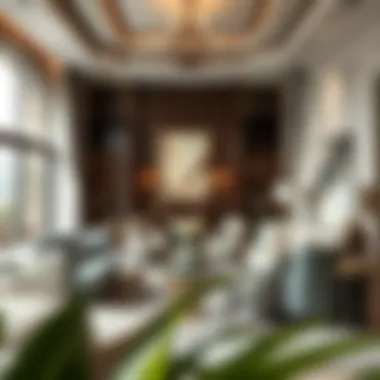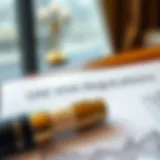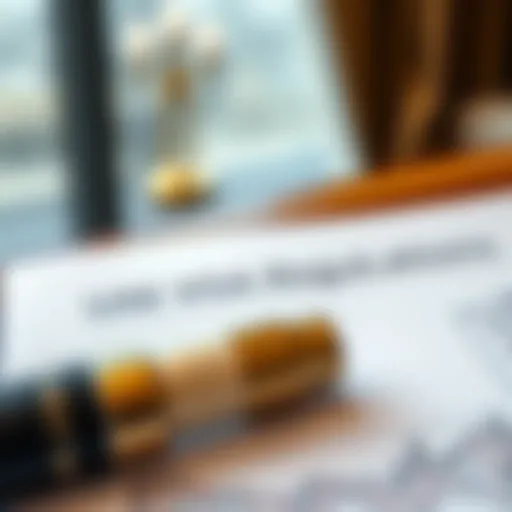Mastering Real Estate Photography for Dubai's Market


Intro
Real estate photography in Dubai is not just about taking pretty pictures; it is about crafting a narrative that speaks to potential buyers and renters alike. The city's dynamic property landscape necessitates a keen understanding of local trends and an appreciation for the unique features that each property offers. In a marketplace as bustling and diverse as Dubai, photography becomes a pivotal marketing tool that can not only attract attention but also foster emotional connections with potential clients.
With buyers and renters navigating a myriad of choices, showcasing properties in the best possible light—both literally and figuratively—has never been more critical. This guide aims to relay essential techniques and strategies that can enhance your real estate photography skills, ensuring your images resonate amid fierce competition.
Market Insights
Current Trends in Dubai Real Estate
The Dubai real estate market is a vibrant ecosystem that's constantly evolving. In recent years, there has been a noticeable shift towards luxury developments and eco-friendly living options. Properties boasting sustainable features or located in green areas tend to attract a premium from buyers and renters.
Additionally, digital nomadism is on the rise, with expatriates increasingly seeking properties that offer flexible leasing terms. Photographers are advised to emphasize outdoor spaces, communal areas, and views of greenery in their images to appeal to this demographic.
Emerging Areas and Investment Hotspots
The spotlight is currently on areas like Dubai Creek Harbour and Mohammed Bin Rashid City, both translating into lucrative opportunities for real estate investors. Properties here are not just homes; they showcase a lifestyle. Highlighting the unique architectural features of these neighborhoods through photography can significantly influence a buyer's decision.
"As the saying goes, a picture is worth a thousand words, and in real estate, those words can mean the difference between a sale and a missed opportunity."
Investors should keep an eye on the upcoming developments in these regions, as the potential for high returns is palpable. Demonstrating the attributes of these emerging areas through well-thought-out photography can greatly enhance marketability.
Buyer and Renter Guidance
Comprehensive Buying Process in Dubai
Purchasing property in Dubai involves a structured approach. From identifying suitable properties to securing financing, each step is crucial. Having high-quality images that accurately depict properties can serve as a significant advantage in this process.
- Research: Start by understanding the market. Analyze recent sales data and trends in the areas you’re eyeing.
- Viewing: When looking at properties, proper lighting and composition in photographs can showcase space effectively.
- Negotiation: Powerful imagery can help sway negotiations in your favor by presenting a property in the light you wish it to be seen.
Essential Tips for Renters in Dubai
Renters should prioritize clarity and authenticity when viewing properties. Here are a few tips:
- Ask for Real Images: Always request current, unaltered photos of the property. This not only saves time but also builds trust with potential landlords.
- Look At Different Angles: Pictures that capture multiple perspectives of a room can provide valuable context about the layout.
- Pay Attention to Details: A close-up shot can reveal the quality of materials used, which is often key in making a renting decision.
By employing a careful selection of techniques and fostering an understanding of the market landscape, real estate photography can transition from being merely functional to elegantly transformative. The essence of capturing a property in its true form lies in the details and the stories that each photograph tells.
Understanding Real Estate Photography
Understanding real estate photography is fundamental for anyone looking to buy or sell property. In the bustling market of Dubai, where visuals often determine success, photography plays a pivotal role. This section aims to illustrate why a firm grasp of real estate photography can be a game changer, not just for realtors but also for buyers and investors.
The Role of Photography in Real Estate
The value of photography in real estate cannot be overstated. It serves as the first point of contact between a potential buyer and a property. When buyers scroll through listings, the images are what catch their eye. A striking photograph can convey the essence of a home, from spacious living areas to cozy corners. It's not merely about aesthetics; it's about crafting a narrative that invites viewers to envision themselves in that space.
Whether you're selling a luxurious villa or a modest apartment, the quality of the images can significantly influence buyer interest. Properties showcased with professional-grade photography tend to receive more views and, consequently, more inquiries. Moreover, well-composed shots can highlight unique features that buyers might overlook in a walk-through. Think of it this way: you wouldn't present a product in shoddy packaging, would you? First impressions matter.
Target Audience Insights
When it comes to real estate photography, knowing your audience is half the battle won. Different segments of buyers will respond to different styles of photography. For instance, expatriates might prefer images showcasing proximity to social amenities, while luxury buyers often look for lifestyle shots that exemplify exclusivity.
- Investors: They often seek images that showcase the property’s potential returns—space, layout plans, and neighborhood characteristics are crucial.
- Homebuyers: Typically, they desire a portrayal of warmth and livability. Lifestyle photos that depict family spaces can resonate strongly with them.
- Agents and Landlords: Their focus usually lies on highlighting features that set the property apart in a saturated market. An understanding of what various segments prioritize can guide the choice of angles, lighting, and even editing styles.
In summary, understanding real estate photography is more than just snapping pictures; it’s a strategic approach that involves connecting with diverse audiences. Making informed choices about how properties are presented not only enhances visibility but also fosters an essential emotional connection with potential buyers.
The Importance of Authenticity
Authenticity in real estate photography is not just a desirable trait; it’s the cornerstone of effective marketing. When potential buyers scroll through listings, they seek more than just through-the-lens images; they crave a sense of belonging and a connection to the space. Ultimately, authentic visuals can help bridge that gap. Buyers are well-informed these days, and they often perceive when something is off or overly fabricated. This is where authentic photography makes all the difference.
Understanding your audience is key. Homebuyers, especially in the competitive Dubai market, are often looking for more than a house; they want a lifestyle. Authentic photography can provide a window into that life, showcasing the true essence of a property and its surroundings.
When buyers see images that resonate with their expectations and desires, they are more likely to engage with the listing. This engagement is not just a click; it could turn into a visit, which might culminate in a sale. In simple terms, authenticity fuels trust.
Building Trust Through Visuals


Every photograph tells a story, and it’s essential to tell the right one. Trust is built through consistency and honesty. When a buyer feels that a listing accurately reflects what they will experience in person, they are more inclined to take the next steps.
A property captured in its true light, emphasizing unique architectural features or the vibe of a neighborhood, builds a narrative that resonates with viewers. Consider these key points when aiming to establish trust through your visuals:
- Highlight Unique Features: Showcase what makes a property special. Whether it’s handcrafted moldings or an outstanding kitchen island, focus on the details.
- Showcase Real Conditions: If a room is small, capturing it through an authentic lens rather than using wide-angle tricks may create a better connection with potential buyers. They appreciate honest representation.
- Capture the Neighborhood: Depicting the surroundings adds richness. Are there parks, coffee shops, or schools nearby? Let your images tell the tale of the community.
In short, when visuals convey what's real and truthful about a property, buyers form a relationship based on trust, and this can significantly enhance your ability to close a sale.
Avoiding Misleading Representations
The old saying goes, "A picture is worth a thousand words," but it can also lead to misinterpretations if not handled appropriately. Misleading photographs can have serious repercussions, leading to dissatisfaction and a tarnished reputation in the market. Here’s how to steer clear of misrepresentation:
- Stay Clear of Editing Overkill: While post-processing can enhance images, beware of excessive alterations that can create unrealistic expectations. Overly bright colors or heavy contrasts can alter a buyer's perception of reality.
- Be Mindful with Angles: While you want to present a property in the best light, be careful not to use angles that warp the space. Instead, focus on angles that showcase the space truthfully.
- Warranty of Authenticity: If you promise certain features or benefits in your listing, ensure that they are clearly represented in your photographs. Keeping the actual experience aligned with the visuals is essential.
In the end, avoiding misleading representations is not simply about adhering to ethical standards. It’s about maintaining a sustainable business model rooted in trust and transparency, which ultimately leads to customer loyalty and repeat business.
"Pictures may trick the eye, but authenticity speaks to the heart."
By weaving authenticity into the fabric of your real estate photography, you’re not just capturing homes; you’re creating a narrative that connects with the soul of buyers. This connection is invaluable and holds incredible potential for fostering lasting relationships in the competitive landscape of real estate.
Technical Considerations
In the realm of real estate photography, understanding the technical considerations is paramount. This is not merely about capturing images but about weaving a visual narrative that draws potential buyers in. Proper technical knowledge equips an individual with the tools to present properties in their best light—literally and figuratively. Without a grasp of essential equipment, camera settings, and lighting techniques, the goal of stunning visual storytelling becomes elusive. Let's dive into the components that make up this essential technical framework for real estate photography.
Essential Equipment
When it comes to capturing breathtaking real estate photographs, the equipment one uses can make a world of difference. Here’s a breakdown of the critical hardware:
- Camera: A DSLR or mirrorless camera is a solid choice. These types of cameras offer versatility and high image quality, essential for showcasing property details.
- Lenses: Wide-angle lenses are particularly useful, allowing you to capture more of the space in a single shot. A 16-35mm lens can open up rooms and create a sense of expansiveness—important in smaller properties.
- Tripod: Stability is key in real estate photography. A sturdy tripod eliminates the risk of shaky images, especially in low-light conditions. Being able to shoot at slower shutter speeds without blurring is crucial.
- External Flash: Sometimes, the natural light isn’t enough. An external flash or portable LED lights can help fill in shadows and give a more balanced look to the images.
These items should not just be randomly picked; they should match the condition of the property and the specific effects you wish to achieve. Investing in quality equipment pays dividends in the final output.
Camera Settings for Optimal Shots
Getting the right camera settings is a vital part of the process that should not be overlooked. Knowing how to manipulate settings can drastically affect the quality of images captured. Here are some considerations for achieving optimal shots:
- Aperture: A good starting point is an aperture of f/8 to f/11. This range keeps most of your image in focus, ideal for both foreground and background elements. It maintains sharpness across the board.
- ISO: In brighter conditions, keep the ISO low, ideally at 100-200. If you're shooting indoors with less light, you can increase the ISO, but be cautious—too high can introduce noise.
- Shutter Speed: A slower shutter speed will typically require a tripod. Ideally, you want to ensure that everything is stable, particularly in lower light conditions where the risk of blur increases.
By familiarizing yourself with your camera's settings, you'll be able to make quick adjustments that can save a shoot when conditions change unexpectedly. It’s crucial to not just rely on automatic settings but to understand how to achieve the best results with manual adjustments.
Lighting Techniques
Light is often the unsung hero in photography. Understanding how to harness it can transform an average shot into something outstanding. Here's how to make the most of lighting for real estate photography:
- Natural Light: Whenever possible, utilize natural light. Shoot during the "golden hour," which is typically early in the morning or late in the afternoon when the light is soft and warm. This helps to bring out the textures and colors in a more flattering way.
- Artificial Lighting: In darker rooms, supplement natural light with artificial sources. Combining different light sources can create a more balanced look, making spaces feel more inviting. Use soft box lights for a diffused effect, or LED panels for adjustable brightness.
- Window Reflections: Be mindful of reflections in windows. While light coming in is great, you don't want to see yourself or your equipment in the shot. Sometimes, slight positioning changes are all that’s needed to eliminate distractions.
"In photography, there are no shadows that cannot be illuminated."
Key decisions in this realm dictate the clarity and atmosphere of the captured image, ultimately influencing the viewer's emotional response.
Composition Techniques
Composition is the backbone of effective photography. In real estate photography, it can make the difference between a lackluster image and a compelling visual story. When considering composition techniques, photographers must pay attention to various elements that enhance the overall presentation of a property. The way elements are arranged within the frame not only emphasizes key features but also guides the viewer’s eye, helping them to connect with the property on a deeper level.
Framing the Property
When it comes to framing the property, the goal is to create a cohesive image that encapsulates the essence of the home. This means ensuring that the property is centered, properly proportioned, and surrounded by complementary elements that contribute to the overall composition. A well-framed photograph captures the viewer’s attention and encourages them to want to explore the home further.
Things to consider for effective framing include:
- Rule of Thirds: Dividing the image into thirds can help in placing the property at points where the viewer’s eyes naturally gravitate.
- Leading Lines: Use paths, fences, or roads that draw the viewer’s eye toward the house. This technique creates a sense of depth and can highlight the property’s location within its surroundings.
- Natural Frames: Elements such as trees, arches, or windows can serve as natural frames for the property, adding depth and context to each shot.
Framing isn't just about getting the structure right; it’s also about evoking an emotional response. A beautifully presented frame can turn a simple photograph into an inviting image that whispers, "Come on in!"
Utilizing Angles and Perspectives
Utilizing angles and perspectives is crucial in showcasing the character of a property. By changing the height and positioning of the camera, a photographer can create unique images that highlight distinct features and make spaces appear more inviting.
Exploring different angles can include:


- Eye Level Shots: These provide a realistic view as if the observer is standing in the space, promoting a genuine connection to the home.
- High Angle Shots: These can create a sense of spaciousness, ideal for smaller rooms. They can also reveal relationships between different spaces, such as how a kitchen connects with a living area.
- Low Angle Shots: By shooting from a lower perspective, the property can appear more imposing, highlighting details such as architectural features or landscaping.
Experimenting with perspectives can transform a straightforward shot into something striking. Watching how shadows and light play can further enhance these angles, making the image not just functional but also aesthetically pleasing.
Incorporating Surroundings
Incorporating the surroundings of a property into the photography can significantly contribute to the narrative. The context plays a vital role in helping potential buyers visualize the lifestyle that comes with the home.
When photographing a property, it’s important to:
- Showcase Views: Highlighting scenic vistas or outdoor spaces adds value to the listing. If the property has a beautiful garden or a nearby park, include these elements in the shots.
- Neighborhood Features: Capturing nearby amenities, such as schools, shopping centers, and parks offers a complete picture of the environmental context of the property.
- Seasonal Context: Depending on the season, the surroundings can dramatically change the atmosphere of a photograph. A property can look warm and inviting in autumn colors or serene and fresh during spring blooms.
"Properties that harmonize with their environments tell a more compelling story, connecting with potential buyers on a personal level."
In summary, effective composition techniques, such as framing, utilizing angles, and incorporating surroundings, are instrumental in capturing the true essence of a property. This not only helps in enhancing visual appeal but also plays a critical role in attracting potential buyers by fostering a genuine connection to the home.
Stylistic Choices
In the domain of real estate photography, stylistic choices are not just preferences—they are critical decisions shaping how a property is perceived. Effective stylistic elements can turn a simple photograph into a compelling invitation for potential buyers. When anyone flicks through property listings, the images often serve as the first impression. A well-thought-out style can pull in an audience while a hasty one can push them away.
A successful create photo portrays not just the property, but also the feelings and lifestyle that it represents. Choosing the right style can elevate the photography from purely functional to visually enchanting.
Choosing the Right Color Palette
The color palette used during photography plays a significant role in conveying mood and emotion. Different colors invoke various feelings, making it essential to align the chosen colors with the message of the property. Soft, muted tones often create a sense of calm and spaciousness, which can appeal to families looking for a sanctuary. On the other hand, bold and vibrant colors may signify energy and excitement, drawing in younger buyers or those looking for a modern dwelling.
When photographing a pristine apartment in Dubai, using a warm color palette could enhance the cozy appeal of home interiors. For exteriors, a cooler palette can emphasize the elegance and contemporary design of the building.
- Consider these factors when selecting color:
- The architectural style of the property
- The target demographic (what resonates with them?)
- The surrounding environment (how do colors complement the neighborhood?)
If reeling in buyers from international markets, it helps to understand local preferences. Some may be drawn to earthy tones while others may prefer the freshness of pastels.
Minimalistic vs. Detailed Approaches
When it comes to stylistic choices, one big debate surfaces: minimalistic versus detailed approaches. A minimalistic style emphasizes simplicity, where the focus rests solely on the property itself, eliminating distractions. This can often result in a clearer narrative, ideal for high-end real estate aimed at discerning clients who appreciate elegance in simplicity. Here, less truly can be more.
Conversely, a detailed approach combines elements that showcase character and storytelling. Here, every nook and cranny tells a tale about the property, as rich textures and curated decor enhance the connection a potential buyer might feel.
- Benefits of each approach:
- Minimalistic:
- Detailed:
- Enables viewer to focus on property features
- Reduces clutter, making spaces appear more spacious
- Conveys warmth and life, enticing emotional engagement
- Highlights uniqueness of the property, perfect for luxury markets
When deciding your approach, think along the lines of the type of audience you want to attract.
In Dubai, where extravagant living spaces abound, incorporating both styles subtly can resonate with a wide range of buyers.
Ultimately, harmonious stylistic choices enrich the photographic narrative, ensuring that every image doesn’t just represent a property but communicates a deeper experience that a buyer can step into.
"Effective real estate photography is not only about how well you capture an image, it’s also about how well you tell a story through style and choice of photography.”
By carefully crafting these choices, one doesn’t just create pictures, they create a persuasive visual journey that invites potential clients to see themselves in the space.
Post-Processing Techniques
Post-processing techniques play a pivotal role in the presentation of real estate photography. This phase is where images transform from simple photographs into compelling visual narratives that engage potential buyers. It’s not just about adjusting brightness or cropping; it involves a thorough refinement of every pixel to reflect the true essence of a property while still appealing to the viewer’s imagination.
Editing for Clarity and Authenticity
Editing for clarity and authenticity ensures that photographs maintain their integrity while enhancing their aesthetic appeal. The balance here is crucial. On one hand, clarity involves sharpening the image, correcting distortions, and ensuring that the colors portrayed accurately reflect the real-life environment. No buyer wants a property that looks drastically different than it does in photos. Clarity creates a sense of trust, helping buyers visualize themselves in the space.
Consider these editing techniques:
- Color Correction: Adjust the hues to reflect the property’s true colors. Incorrect colors can mislead buyers and damage trust.
- Lens Correction: Fix any distortion that may occur from wide-angle lenses, ensuring lines remain straight and true to reality.
- Sharpening: Enhancing details like texture in materials—like wood or fabric—can help portray a feeling of quality in the space.


"In the world of real estate photography, clarity is the name of the game; it’s about painting an accurate portrayal of a space, devoid of gimmicks or tricks."
By focusing on authenticity, you also give potential investors a genuine insight into the property, leading them to make informed decisions instead of feeling deceived.
Balancing Realism and Enhancement
Finding the right harmony between realism and enhancement is a delicate dance in post-processing. While clarity is essential, enhancement can help highlight the property’s best features. During the editing phase, the goal is to create images that attract attention while still remaining genuine.
Here are some considerations:
- Highlighting Features: Use tools such as dodging and burning to subtly accentuate desirable aspects of the home, like high ceilings or intricate molding without making them look artificial.
- Dynamic Range: Leverage HDR techniques to capture a wider tonal range, ensuring that both the highlights and shadows contribute to the overall balance of the image. This approach can showcase spaces in their best light, literally and figuratively.
- Avoid Over-Editing: While enhancement can make images pop, be wary of going overboard. An artificially brightened photo might grab attention initially but can lead to disappointment during in-person viewings. Keeping an eye on realism maintains the property’s credibility.
By merging both clarity and enhancement in post-processing, photographs become powerful tools that not only allure but also depict the reality of the property at hand. This thoughtful approach resonates deeply with the discerning buyers of today, especially within the dynamic market of Dubai real estate.
Market Trends and Adaptations
In today’s fast-paced real estate market, keeping pace with emerging trends isn’t just smart; it’s essential for success. Real estate photography in places like Dubai has witnessed a notable evolution, driven not only by the rapid growth of technology but also by shifting buyer expectations and preferences. Understanding and adapting to these trends can significantly enhance the effectiveness of property listings and ultimately lead to quicker sales.
Emerging Styles in Dubai Real Estate Photography
The voice of the market dictates a shift in real estate photography styles. As visual storytelling becomes increasingly critical, several styles have gained traction in Dubai’s competitive landscape. For instance, drone photography has become a game-changer. It offers a unique perspective, helping potential buyers to grasp the scale and layout of a property and its surroundings, something that standard photography might miss.
Alongside drones, the trend of 360-degree virtual tours has been on the rise, allowing buyers to navigate through properties at their own pace. This approach not only caters to remote buyers but also makes the experience more interactive. Properties often advertised with dynamic visual content attract more attention, leading to higher engagement rates. Consider the increasing use of natural light in images—this simple aspect can dramatically enhance the desirability of a property. Not only does it create a warm ambiance, but it also highlights the architectural elements that buyers cherish.
"Outshining competitors in the real estate market means embracing creativity in visual representation; what’s on the surface often speaks volumes to a buyer's deeper aspirations and lifestyle."
Adapting to Buyer Preferences
Every market has its pulse, and in Dubai, understanding what buyers want is key. Aesthetic preferences are shifting towards minimalism and clean lines. Properties that are cluttered or overly staged can deter potential buyers. Instead, showcasing a clean, spacious aesthetic seems to resonate better. It allows buyers to visualize themselves in the space, making it feel more approachable.
Another element to consider is diversity in marketing materials. Potential buyers today are not just looking at listings; they're browsing through social media platforms, websites, and online ads. Photographers need to ensure images are optimized for various formats. Social media platforms like Instagram demand striking visuals that can stand out in crowded feeds.
In addition, cultural nuances play a role in how properties should be presented. With a mélange of nationalities converging in Dubai, it’s wise to recognize and cater to the unique preferences of different buyer demographics. For example, while Western expatriates might gravitate towards open spaces and modern designs, buyers from Asian markets may prefer traditional aesthetic elements.
Ultimately, success in real estate photography hinges on an adaptable strategy—one that recognizes and reacts to market changes. This flexibility will serve not just the photographers but the entire real estate industry, showcasing properties in a manner that feels both genuine and relatable.
The Future of Real Estate Photography
The landscape of real estate photography is poised on the brink of transformation, powered by the rapid progression of technology and shifting market dynamics. In a bustling metropolis like Dubai, where the skyline constantly evolves, staying attuned to these changes is vital for photographers and realty professionals alike. The emphasis here is on how technology can enhance the visual storytelling of properties, making them more appealing to potential buyers. With expectations on the rise, understanding these future trends isn't just advantageous; it’s essential for anyone looking to thrive in the real estate market.
Incorporating Technology
As technology strides forward, so do the opportunities for enhancing real estate photography. A slew of tools exist that can elevate standard pictures into captivating visual narratives. Consider the following technologies:
- Drones: Drones have seriously changed the game, allowing aerial shots that can capture stunning views of properties and their surroundings. A bird's-eye perspective makes homes more appealing by showcasing the entire property, nearby amenities, and the neighborhood context, which can be especially valuable in Dubai where location matters significantly.
- 360-Degree Cameras: Virtual tours using 360-degree cameras are becoming a staple in property listings. They provide an immersive experience, letting potential buyers explore spaces as if they were physically there. This can profoundly impact buyers making decisions from afar.
- Augmented Reality (AR): Imagine viewing a property listing and being able to visualize how different furniture arrangements would look, or seeing renovation possibilities in real-time. This technology enables potential buyers to imagine themselves in the space, significantly enhancing their engagement.
Potential Shifts in the Market
It's not just technology that’s influencing the future of real estate photography; market trends are evolving too. Recognizing these shifts can mean the difference between capturing interest and missing opportunities. Here’s how the market is changing:
- Sustainability Focus: As more buyers become environmentally conscious, there's a growing demand for showcasing energy-efficient features of homes. Photographers must adapt by emphasizing such traits in their images – from energy-efficient appliances to sustainable materials.
- Cultural Representations: In a diverse place like Dubai, properties resonate differently with various cultural backgrounds. Understanding these cultural nuances is vital. A photographer must capture homes in a way that speaks to different demographics, thus attracting a broader audience.
- Personalization: Today's buyers are seeking more than just images of bare rooms; they want to see how these spaces could fit their specific lifestyles. Tailoring photographs to highlight areas such as family spaces, outdoor entertainment spots, or home offices is becoming increasingly important.
Technology combined with a thorough understanding of market trends can redefine how real estate photography appeals to buyers, creating unique selling propositions that speak to their desires.
As we look ahead, the interplay between innovative technology and evolving market preferences will set the stage for the next chapter in real estate photography. Embracing these changes will allow photographers to capture not just images, but narratives that resonate deeply with potential buyers.
Finale
In wrapping up our discussion on real estate photography, it’s important to emphasize the fundamental role this craft plays in the larger landscape of property marketing. The eye of a skilled photographer can transform mere images into compelling narratives that resonate with potential buyers. This is especially crucial in a dynamic market like Dubai, where properties are not just bought for shelter but are also seen as investments and lifestyle choices.
Recapping the Role of Photography in Real Estate
Real estate photography is more than just snapping a few pictures—it is about telling a story. Each image conveys the essence of a home, revealing its character and inviting viewers to envision themselves living in that space. For agents and sellers alike, quality photography can bolster engagement, enhance online listings, and significantly impact how quickly a property sells. When photographs are crafted with care, they not only represent property features accurately but also evoke emotion. This emotional connection is often what drives potential buyers to make inquiries or even offers.
Furthermore, in a visually-driven market, having a robust portfolio of quality images has become a vital differentiator. Properties that are presented through professional photography are often perceived as more valuable than those with amateur shots. Thus, investors and agents must recognize photography as a strategic asset.
Final Thoughts on Best Practices
As this article illustrates, several best practices underpin successful real estate photography strategies. Here are a few final considerations that can elevate your approach:
- Invest in quality equipment: A solid camera and the right lenses can make or break a shoot. It pays off to use equipment that can handle varying light conditions.
- Consider the property’s unique features: Different homes require different looks. Tailor your approach based on what stands out in a property, whether it’s an expansive pool or a cozy nook.
- Optimize for online platforms: Keep in mind the specifications and requirements of various listing sites to ensure your images are presented at their best.
- Engage an expert when needed: Sometimes partnering with a professional photographer is worth it. Their techniques and industry knowledge can provide unrivaled results.
In summation, the impact of well-executed real estate photography extends beyond aesthetics. It builds trust and lays the foundation for successful transactions. Going forward, as the market evolves, photographers must remain adaptable, learning not only the craft but also the intricacies of real estate marketing to thrive in this competitive environment. For more insights, check out resources like National Association of Realtors and American Society of Media Photographers.















